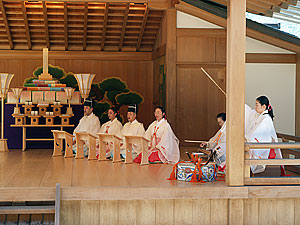Frequently Asked Questions
About Oomoto
Q-What is Oomoto?
A-Oomoto is a Sectarian Shinto sect and one of Japan’s “New Religions.” (Sometimes it is spelled Omoto and also referred to as Omotokyo.)
Q-What are Japan’s New Religions?
A-Since the middle of the nineteenth century, hundreds of religious sects, many based on Shinto and some on Buddhism, were founded. Several dozen still exist, a few of them large and thriving. Although Oomoto is not the largest, it is often cited as one of the more influential New Religions for many reasons: it gave birth to several other sects, which spun off from it amicably in most cases; it was an early proponent of interfaith cooperation, which today is widely practiced by Japanese religions; and it had a highly public and sometimes tragic history in its first fifty years.
Q-What is Shinto?
A-Shinto is the original folk religion of Japan. Sometime after Buddhism arrived from China and Korea around 600 AD, the name “Shinto” was coined to describe the indigenous beliefs practiced since before recorded history. Shinto means “the way of the gods,” to distinguish it from “the way of Buddha.”

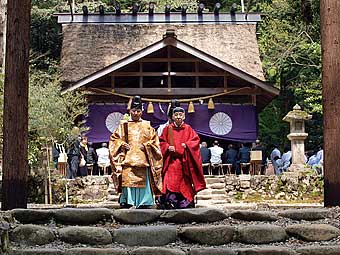
Q-How is Oomoto like Shinto?
A-The importance of harmony among nature, humans, and gods is a key belief of both. Oomoto’s rituals, architecture, and vestments are based on the ancient original practices that became known as Shinto.
Q-How is Oomoto different from Shinto?
A-Shinto is polytheistic, believing there are many gods – or kami. Oomoto teaches that many kami do exist, but they all come from the same Supreme God of the Universe, so in effect there is just one God. When Oomoto followers pray to a particular kami by name they understand this is just one manifestation of the single God. Even the name “Oomoto” emphasizes this point. It translates as “Great Source” or “Great Origin.”
Q-Is this different from Biblical monotheism?
A-Oomoto is monotheistic but not exactly like Judaism, Christianity or Islam. Religion scholars often describe the Biblical religions as “exclusive monotheism,” meaning the religions believe there is only one God and all others are false. Scholars describe other religions, like Oomoto, as “inclusive monotheism,” meaning the religions believe many gods may exist but all are essentially the same and come from one source; therefore it doesn’t matter under which name or ritual God is worshipped. Oomoto teaches that all gods, religions, prophets and messengers throughout time came from the same source – the Supreme God of the Universe. This teaching is one reason Oomoto is active in interfaith efforts and partly explains why it does not have a strong missionary goal to win converts.
Q-What is Oomoto’s basic doctrine?
A-God is the spirit which pervades the entire universe, and man is the focus of the workings of heaven and earth. When God and man become one, infinite power will become manifest.
Q-What is the essence of Oomoto beliefs?
A-God, with the help of humans, is working to purify and reconstruct the world. When this task is accomplished, God, humans, and all of nature will exist peacefully on earth and in the spiritual world.
Q-What are humans expected to do to help?
A-They should live according to four teachings and four principles. These are fundamental to the Divine Plan and applicable to the lives of all humans. Oomoto also teaches that God gives humans freedom of choice; they have freewill to decide whether to follow these teachings and principles.
Q-What are the teachings?
A- They are: 1) Harmonious alignment with all life and the universe. 2) Revelation of celestial truth and its lessons. 3) Innate patterns of behavior for man, society and the cosmos. 4) Instinctual creative drives.
Q-What are the principles?
A- They are: 1) Purity through purification of mind and body. 2) Optimism, specifically believing in the goodness of the Divine Will. 3) Progressivism as a way to social improvement. 4) Unification or reconciliation of all dichotomies (good and evil; rich and poor; humans and nature; humans and God, etc.) The four can be thought of as a code for right living. By practicing them, humans can live in harmony with the universe and lead a heavenly life in spirit and flesh.
Q-What are some of the things Oomoto followers do to live by this code?
A-They try their best to live a spiritual life on a daily basis. This means taking the broadest view in any situation and trying to understand its essence; turning the heart toward the Divine Light, or Wisdom; trying to understand the will of God; exerting their utmost in all things and all moments; ultimately trusting their lives to God. More concretely, Oomoto followers pray twice a day and conduct a monthly service in their home shrines; usually attend a monthly service at their local branches; read a bit of scripture each day; and try to participate as much as possible in Oomoto’s many activities—pilgrimages, arts, and special rituals.
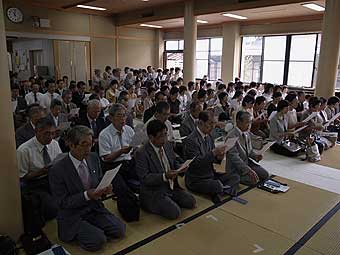

Q-Who founded Oomoto?
A-Nao Deguchi (1837-1918) of Ayabe founded the sect in 1892.
Q-Who was Nao Deguchi?
A-She was a poor, illiterate widower with many children who, despite a lack of formal education, was intuitively intelligent and spiritually wise. She lived a pure and pious life in accord with traditional Shinto. She began life as a weaver (in old Japanese Ayabe means “place of the weavers”), and was eking out a living for herself and two youngest daughters as a lowly rag picker when she had her first divine revelation.
Q-What was the divine revelation?
A-On the night of February 3, 1892, at her home in Ayabe, Nao became possessed by a god who identified himself as Ushitora no Konjin. He declared that 3,000 years earlier the other kami had convinced him they could run the world and demanded he let them do so. He secluded himself on an island for three millennia, but then saw what a mess the kami had made. In his first possession of Nao, he declared through her voice that he had returned to purify and reconstruct the world.
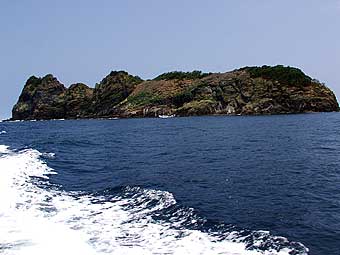
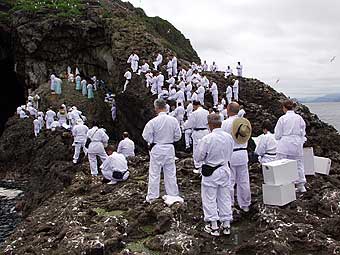
Q-You said first divine revelation, were there more?
A-Yes, the possessions and divine revelations came almost daily, each time Ushitora no Konjin forcing his words through Nao in a boisterous voice. She finally convinced him that his outbursts were causing her trouble, and that he should find another way to communicate. Soon after, she began to transcribe his declarations, prophecies and instructions through automatic writing. Although illiterate, she would pick up a brush and her hand would automatically write things she could not read. Literate people were able to make some sense of the writings. In the last 26 years of her life, Nao recorded more than 200,000 pages of statements from Ushitora no Konjin.
Q-Besides transcribing God’s words, what else did Nao do?
A-Ushitora no Konjin told her to start Oomoto. In the early days she found it difficult to convince anyone that her spirit possession was genuine. Eventually, the automatic writing convinced many, and Nao also discovered she had healing powers, which helped her attract followers. She attracted a following from Ayabe, but Oomoto remained small until she met Kisaburo Ueda.
Q-Who was Ueda?
A-Kisaburo Ueda – who became Onisaburo Deguchi (1871-1948) -- was the first born son of a farmer in a village near Kameoka, which today is part of Kameoka. After his father died he lived a dissolute life for a few years. One night when he was 26 years old he was beaten by a gang of thugs and left for dead in a rice paddy. Friends discovered him and took him to the nearest shrine to recover. There, a spirit guide appeared to Ueda and led him to a cave on nearby Mount Takakuma.
Q-What happened in the cave?
A-Ueda underwent spiritual training over the next seven days. Unlike Nao, Ueda had an out-of-body experience, led by a guide into the spiritual world, where he witnessed the past, the present, and the future. Many years later, he described these experiences in his 81-volume “Reikai Monogatari” (“Stories from the Spiritual World”). After his week of training, Ueda tried to attract a following with little success. Soon, however, the kami guiding Ueda and the god guiding Nao directed them to a meeting.
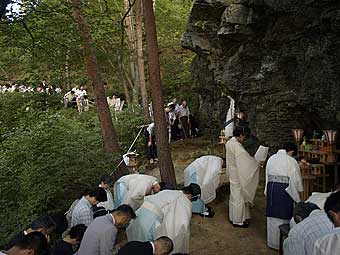
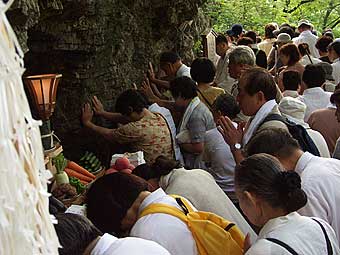
Q-How did Nao react to Ueda?
A-Ushitora no Konjin had promised Nao that she would meet a man who would help her build Oomoto into the organization that would help the reconstruction. She initially was surprised that this person was a brash, young man. Eventually Nao and Ueda decided it was God’s will that they would work together. On New Year’s Day 1900, Ueda married Nao’s youngest daughter, Sumiko (1882-1952), took the name Onisaburo Deguchi, and became Co-Founder. From then on, the Foundress and the Co-Founder worked diligently together to spread the word of Ushitora no Konjin and to build a religious organization to achieve his goals.
Q-Why the need for a woman and man to work together?
A-Oomoto teaches that Nao had the purity necessary to serve as the vessel to directly receive God’s words, and that Onisaburo had the spiritual training and insight necessary to interpret the writings that Nao transcribed. Nao’s transcriptions are also filled with references to the necessity of opposites coming together. For example, the analogy of warp and weft in weaving appears often. Ushitora no Konjin is consistently clear that the joining of polar opposites is one key leading to the reconstruction of the world.
Q-Why does Oomoto have a female Spiritual Leader today?
A- In keeping with Ushitora no Konjin’s instructions, the Spiritual Leader of Oomoto is always a woman, a descendant of Nao on the matrilineal line. Sumiko became Second Spiritual Leader after Nao died; Naohi (1902-1990), eldest daughter of Sumiko and Onisaburo, was Third Spiritual Leader; Naohi’s daughter Kiyoko (1935-2001) was Fourth Spiritual Leader; and Mme. Kurenai Deguchi (born 1956), a great great granddaughter of Nao, is the Fifth (current) Spiritual Leader. In keeping with Ushitora no Konjin’s instructions, the administrative chief is always a man, but not always a Deguchi.
Q-What is the role of the Spiritual Leader?
A-Oomoto followers believe their Spiritual Leader has direct contact with the Divine Spirit. Based on this she interprets the teachings according to present circumstances – social, political, etc. --and guides the spiritual activities of Oomoto followers. The Spiritual Leader is an active participant in most major and many minor rituals throughout the year.
Q-What is the role of the chief administrator of Oomoto?
A-With the help of the small staff and many volunteers, the chief leads the sect’s efforts to actualize the interpretations of the Spiritual Leader through its programs and policies.
Q-How many members does Oomoto have?
A- Oomoto’s official membership count is 170,000 people.
Q-How is Oomoto organized today?
A-Because Oomoto had two founders it has two headquarters. Ayabe is the spiritual headquarters, and Kameoka is the educational/administrative headquarters. Oomoto has fewer than 200 paid staff, most based in Kameoka, several in Ayabe and a few in its Tokyo office. Oomoto has branches throughout Japan, about 60 of various sizes, some with as few as fifty families and some with several hundred. Each branch has a chief – man or woman – who serves as a volunteer. Each branch holds a monthly service – called Tsukinamisai—and has activities for the branch in general, and for youth groups, children’s groups, women, mid-lifers and seniors.

Q- How many priests for all these branches and headquarters?
A-Actually, Oomoto has no professional priests. Some of the paid workers spend much or most of their time engaged in priest duties at the two headquarters. But in Oomoto anyone can become a priest. Men, women, and children are all eligible to study the doctrine and ritual, and to become certified to practice. Many adult priests started out by learning the ritual in their home shrines, where each family has a monthly service. Most branches have several followers who serve voluntarily for priestly duties at monthly services, weddings, funerals, and other rites.

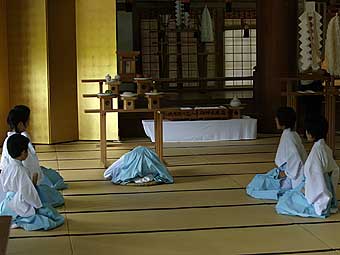
Q-Are there scriptures like other religions?
A-Yes. Nao’s transcriptions became known as the “Ofudesaki,” which means “from the tip of the brush,” and are collectively one of Oomoto’s holy books. They are also known as “Oomoto Shinyu” (“Divine Revelations”). The other holy book is “Reikai Monogatari” by Onisaburo.
Q-Are these available in any languages other than Japanese?
A-Only a few excerpts have been translated into English and Esperanto.
Q-What is Esperanto?
A-A culturally neutral international language created by Dr. L.L. Zamenhof (1859-1917), a Polish Jew and ophthalmologist. When Onisaburo first heard about Esperanto, he declared it to be the language of heaven. Oomoto adopted Esperanto as its universal language in 1923. Many followers study it, and Oomoto promotes Esperanto through conferences, publications, and workshops. A portion of the web site is in Esperanto.
Q-Why the emphasis on a universal language?
A- In the reconstructed world there will be no political or religious strife or competition, all will work for the same goals of peace, harmony and prosperity for the planet and all its inhabitants. A neutral universal language in addition to each person’s native tongue is essential to achieving this goal.
Q-You alluded to interfaith work. What is that?
A-Oomoto promoted interfaith activities long before most religions acknowledged the importance of interfaith dialogue and prayer. Onisaburo interpreted the Ofudesaki as instructing Oomoto to do this. He called this Bankyo Dokon – which loosely translates as “all religions spring from the same root.” In the past fifty years, many religions have adopted interfaith policies. Interfaith activity has always been a part of Oomoto’s doctrine and one of its missions from the beginning. Onisaburo organized what is believed to have been the first interfaith meeting of Asian religions -- in Beijing in 1923. Today, Oomoto has interfaith relations with many religions in Japan and abroad.

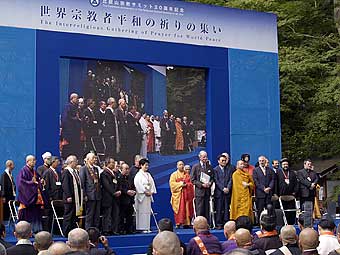
Q-You mentioned a tragic history. What was that?
A-Twice in the first half of the twentieth century Oomoto was shut down by the Imperial Japanese government. These are known as the First and Second Incidents, but they were more like persecutions, especially the second one. The first began in 1921. Onisaburo and a handful of other Oomoto leaders were briefly imprisoned, some property was seized, and some shrines were destroyed. In 1925 the emperor died and a general amnesty was declared, bringing an end to the First Incident.
Q-What happened in the Second Incident?
A-The Second Incident began in 1935 and lasted until nearly the end of World War II. About 1,000 Oomoto leaders and followers were imprisoned, some briefly and others for years. Many were tortured in an attempt to get them to reject their beliefs. Onisaburo and Sumiko were not tortured, but they were put on trial, found guilty of lese majeste and imprisoned for more than six years in prison. Most Oomoto shrines and buildings were destroyed, and all property confiscated. After the war, everyone was exonerated, all property was returned, and the government offered to pay for damages. Onisaburo declined, saying Japan did not need the burden of paying Oomoto when it was trying to rebuild from the destruction of war. The Japanese constitution adopted after World War II protects freedom of religion, and there have been no further incidents.
Q-Why did the government shut down Oomoto?
A-By 1921, Oomoto had a huge following. And Onisaburo was outspoken about the Imperial Japanese government’s increasingly militaristic policies. He even bought a daily newspaper and used it as his podium. Onisaburo believed that the material problems of the world needed spiritual solutions. The government became deeply concerned that Oomoto and Onisaburo could foment an uprising. By the time of the Second Incident, Japan was ruled by a military dictatorship which was tough on all dissenters. Oomoto was one of several religions shut down. The government also squelched progressive political organizations, liberal thinkers, artists and intellectuals.
Q-You mentioned harmony with nature. How is that important?
A-As in traditional Shinto, Oomoto believes in the importance of harmony between humans and nature. At Oomoto, in Shinto, and throughout traditional Japanese culture, this manifests itself in the importance of beauty and the arts. There is a close link among nature, art, and religion. Creating beauty through art is one way to help with the purification and reconstruction of the world. Onisaburo said, “Art is the mother of all religions.”
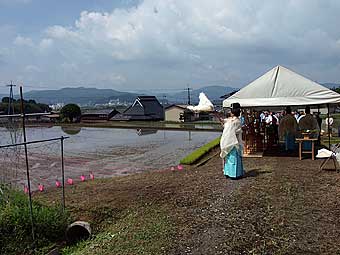
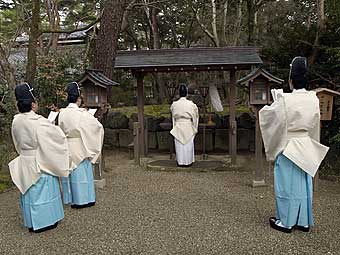
Q-What did he mean?
A-He explained in an essay in 1923: “Everything under the sun, created by the great power of the Maker, is one and all artistic products of God. To touch this great artist, i.e., the Creator’s inner truth, be delighted with Him, live with Him and be active with Him should be the true religion. … Art is to guide mankind to the heavenly kingdom through the gateway of beauty while religion intends to lead them through that of good and truth.”
Q-What role do the arts play at Oomoto?
A-Since God is the greatest artist human beings honor God when they make art, Oomoto teaches. Oomoto followers believe that doing the arts is a religious practice. Onisaburo and the Spiritual Leaders, beginning with Sumiko, have set the example. They were all amateur artists, in some cases advanced amateurs in the traditional arts: calligraphy, tanka poetry, Noh drama, tea ceremony, weaving, ceramics, and others. The current Spiritual Leader weaves, makes tea bowls, and is a tea master. Near the end of his life, Onisaburo made and decorated nearly 3,000 tea bowls, which are regarded as spiritually inspired. Many Oomoto followers practice the arts for self improvement and to praise God. Some Oomoto branches offer programs to help members learn tanka poetry, calligraphy, martial arts, tea and Noh.
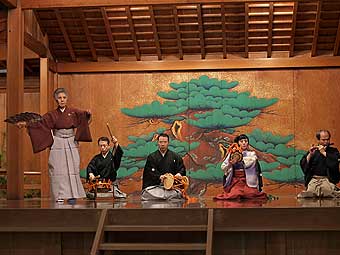

Q-You mentioned martial arts. What is Oomoto’s connection to Aikido?
A-The founder of Aikido, Morihei Ueshiba (1883-1969), became a disciple of Onisaburo Deguchi and an Oomoto follower after he first visited Ayabe in 1919, when he was 36 years old. He found the teachings of peace and harmony of Oomoto to be very much in keeping with his fledgling effort to create a new kind of martial art that respected all participates in the practice. Many Oomoto followers practice Aikido and other martial arts, and emphasizing the “art” in martial arts, as expressed above.
Q-Tell me about the ritual.
A-The basic ritual, practiced at each branch, at each headquarters and in each home once a month is called Tsukinamisai. In it, Oomoto followers express their gratitude to the spirit by a token return of the basic necessities, placed with reverence upon the altar. Food, clothing, and shelter, the requisites of daily life, are reverently offered during the ceremony.
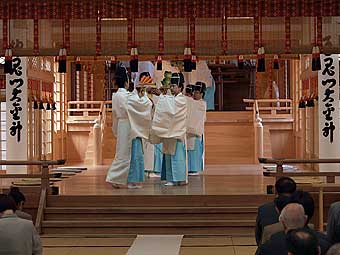
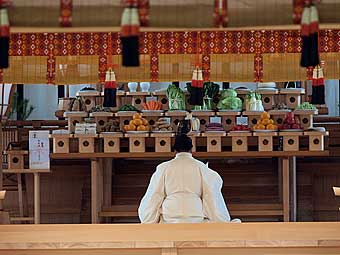
Q-Besides Tsukinamisai, what other celebrations does Oomoto have?
A-There are four Grand Festivals. Spring, Summer and Autumn are held in May, August and November, respectively. Setsbun Grand Festival is the most important, held each Feb. 3, the date of the sect’s founding. Setsubun is an all-night prayer and purification vigil, with at least one male and one female priest from each branch participating, in addition to the Spiritual Leader and other key priests. Thousands of followers attend each year. Spring, Autumn and Setsbun festivals are held in Ayabe, and the Summer festival is in Kameoka.
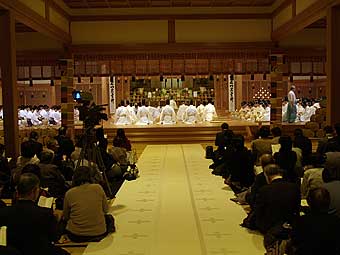
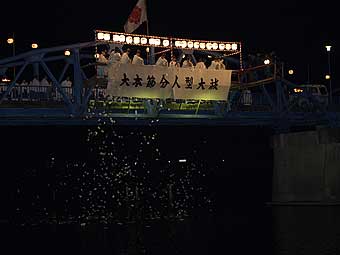
Q-Any other rituals?
A-Oomoto also holds regular observances at some of the mountains and islands that played an important part in its early history. And one of the more colorful rituals, conducted at least twice a year, is the ancient poem festival, called Utamatsuri, which Oomoto revived in 1935.
Q-Certain aspects of the story of Nao and Onisaburo might seem incredible to some. Is there anything else you can say about it?
A-Oomoto believes that God has been revealed throughout human history to many people in many cultures, in ways appropriate to the time and place. We can’t create faith where none exists, but consider this: Nao’s first divine revelation, in 1892, occurred in the middle of a century of worldwide spiritual ferment. And this period coincided with a time of economic and political upheaval in the material world. Japan was not alone in seeing New Religions spring up. Several other religions were founded during these 100 years, including the Mormons (1830), Bahai (1863), Christian Science (1879), Dao Yuan in China (1921), and Cao Dai in Vietnam (1926), to name just a few. It is also worth noting that Nao’s daily contact with this immense spiritual power was similar to the divine revelations described by some Old Testament prophets. The automatic writing was similar to experiences described by Teresa of Avila and other European Christian mystics of the fourteenth and fifteenth centuries. Onisaburo’s travels in the spiritual world were similar to experiences reported by Old Testament prophets, some Christian mystics and shaman throughout the ages in various cultures.
Q-Are there books about Oomoto in languages other than Japanese?
A-Yes, there are several.
Available online:
"Divine Signposts," by Onisaburo Deguchi.
"The Creation of Meaning," by Hidemaru Deguchi.
"Nao Deguchi — A Biography of the Foundress of Oomoto," by Sakae Oishi.
Also available:
*“Prophet Motive: Deguchi Onisaburo, Oomoto, and the Rise of New Religions in Imperial Japan,” by Nancy K. Stalker. University of Hawai’i Press, Honolulu, Hawai’i. (2008)
“A Portrait of Oomoto,” by Bill Roberts. Tenseisha Press, Kameoka, Japan. (2006)
The first chapter of the book is available online.
“Omotos mission pa esperanto,” Lief Nordenstorm, Esperantoforlget, Eldona Societo Esperanto, Stockholm. (2002) Esperanto only
*"The Great Onisaburo Deguchi," by Kyotaro Deguchi, Aiki News, Sagamihara-shi, Kanagawa-ken, Japan. (1998)
“In Search of Meaning,” by Hidemaru Deguchi, the Oomoto Foundation, Kameoka, Japan. (1994) Also available in Esperanto
"Nao Deguchi — A Biography of the Foundress of Oomoto" by Sakae Oishi. The Oomoto Foundation, Kameoka, Japan. (1982)
*"Women and Millenarian Protest in Meiji Japan: Deguchi Nao and Omotokyo," by Emily Groszos Ooms, Cornell University, Ithaca, NY. (1983)
*"An Encounter with Oomoto," by Dr. Frederick Franck, Cross Currents. (1975)
"Omoto" by Jean-Pierre Berthon, Atelier Alpha Bleue, Paris. (1985) French only
*Available from Amazon as of June 2008
“A Portrait of Oomoto,” “Nao Deguchi,” and “In Search of Meaning,” can be acquired from the Oomoto International Department. Contact the Rev. Masimichi Tanaka, Chief Director of the International Department, at: E-mail: m-tanaka@oomoto.or.jp
New Contents Thu, May 20, 2010
- Oomoto participates in Sant’Egidio conference : Dialogue among religions and cultures : On divided island nation of Cyprus By Bill Roberts
- Photo Album : Portraits of three branches: Shoko, Tanegashima and Aomori By Bill Roberts
- Oomoto FAQ
- A Letter from Oomoto : Of mountains and myths By Bill Roberts
- Polyglot poem festival The Utamasturi is going international — what’s next? By Bill Roberts
- Ethics education program captures the spirit of Bankyo Dokon By Bill Roberts
- A Letter from Oomoto : A year’s worth of adventure in a summer of branch visits By Bill Roberts
- In Kumamoto, it’s all about water – and fire By Bill Roberts
- A speech by Nevada Taylor at the Kii Branch in Wakayama Prefecture on April 13, 2008.:An Encounter With Oomoto Through Aikido
- Utamatsuri, Poem Festival, in Tokyo(on April 17, 2008)
- A speech by Neil Ryan Walsh at the Kobe branch on Mar. 9th, 2008.:Planting the Seeds of the Soul
- Meeting with the Fifth Spiritual Leader of Oomoto, Madame Kurenai Deguchi by Neil Ryan Walsh
- A speech by Neil Ryan Walsh at the Nagoya branch on Feb. 17th, 2008.:The Japanese Arts beyond National Boundaries
- To the Oomoto branch in Nagoya: City of Eel and Toyota by Neil Ryan Walsh
- A Speech by Nissim Ben Shitrit, Ambassador of Israel on the occasion of the Oomoto Setsubun Grand Festival in Ayabe February 3rd, 2008 : Japan and Israel : Two Lands Balancing the Needs of Traditional Culture and Modern Life. r
- A permanent memorial to Onisaburo (A Speech at the Autumn Grand Festival , November 6, 2007 : )By James Parks Morton, Founder and Chair, Emeritus of The Interfaith Center of New York
- Israel, Palestine and the Power of Poetry(Oomoto believes small efforts can have lasting ripple effects on people and peace)By Bill Roberts
- “Something Great”(This genetics pioneer, a friend of Oomoto, offers a clue to the mystery of life)By Bill Roberts
- Kamishima Cleanup (Harima branch members regularly visit this sacred island to keep the shrine tidy)By Bill Roberts
- Kyotaro Deguchi was one of six recipients of the 2007 James Parks Morton Interfaith Award
What is Oomoto?
- What is Oomoto?
- Spirtual Centers
- Founders and Spiritual Leaders
- History
- Organization and activities
- Teachings and scriptures
- Art Works of Founders and Leaders
Opinions[Archive]
- Statement of regret for the outbreak of war against Iraq (March 20,2003)
- Jinrui Aizenkai dispatched the "Urgent Appeal for a World (Global) Crisis" on March 14.
Grappling with Bioethics[Archive]
- Oomoto’s support for abolishing the death penalty (12, June 2003)
- The Oomoto Foundation protests any birth of a human clone baby. (5, January 2003)
- OOMOTO'S VIEW REGARDING JAPAN’S PERMITION TO THE RESERCH OF HUMAN EMBRYONIC STEM CELLS (ES cells)(12, June 2000)
Vistor’s Review[Archive]
- A speech by Bill Roberts at the Oomoto branch in Hiroshima after its monthly service on March 18, 2007:Encounters with war and peace
- How Bankyo Dokon changed one life by Linda Macphee
- A speech by Bill Roberts at the Hokuriku (Kanazawa) branch on Dec. 3, 2006:Ritual and myth -an encounter with ‘divine madness’
- A speech by Bill Roberts at the Himeji Cultural Center on Feb. 25, 2007:Mesmerized by the Japanese Arts
- A speech by Bill Roberts at the Kobe branch on Feb. 11th, 2007.:There are just human tears and human joy
- A Speech on the occasion of the Oomoto Setsubun Grand Festival in Ayabe February 3rd, 2007 : Egypt's role in Middle East peace
- Keynote Speech for the 28th World Federation Japanese Religionists Conference for World Peace in Tokyo (at Kokugakuin University, Novermber 29, 2006):Vision for Peace in the Middle East By Dr. Munther S. Dajani, Professor Dean, Faculty of Arts, Al Quds University, Jerusalem
- A speech to the Kyoto branch:Spiritual adventures in researching Oomoto leaders
- A Speech at The Oomoto Foundation on Monday, November 6, 2006 : Jordan's role in Middle East By Samir Nouri, Ambassador of the Hashemite Kingdom of Jordan
- A letter from Oomoto:The Young People of Tottori
- A speech by Bill Roberts on the occasion of the dedication ceremony for the new shrine of Tottori Branch By Bill Roberts Oct. 8, 2006
- A speech by Bill Roberts at the Oomoto branch in Hiroshima after its monthly service on March 18, 2007:Encounters with war and peace
- How Bankyo Dokon changed one life by Linda Macphee
- A speech at Setsubun : A Portrait of Oomoto By Bill Roberts Feb. 3, 2006
- New Publication ! By Bill Roberts Feb. 3, 2006 A Portrait of Oomoto
you can read this book in html => http://www.jinruiaizenkai.jp/English/en-kolumno/en-bill/en-sugao/billbook1en.html
E-mail below to order brobert1@ix.netcom.com
Current Topics
- Prayer Offering and World Religious Forum II
- Living the art of dialogue
- Kyotaro Deguchi was one of six recipients of the 2007 James Parks Morton Interfaith Award
Books
Online Books
- Divine Signposts by Onisaburo DEGUCHI
- The Creation of Meaning by Hidemaru Deguchi
- Bankyo Dokon(Seventy years of Inter-Religious Activity at Oomoto)
- Nao Deguchi — A Biography of the Foundress of Oomoto
- The Great Onisaburo Deguchi published by Aiki News
- Bankyo Dokon Seventy Years of Inter-Religious Activity at Oomoto
- Insearch of Meaning
- Nao Deguchi A Biography of the Foundress of Oomoto
- A Portrait of Oomoto By Bill Roberts
Oomoto international Archive
- The History of Oomoto (Jan.– Mar. 1980 — Apr.– Jun. 1982)
- The Ancestors; Friends or Foes? (Apr.– Jun. 1987)
- Tsukinamisai; The Sabbath of Shinto (Jan.– Jun. 1983)
- The Poem Festival at Oomoto; An Ancient Rite Lives Again (Oct.– Dec. 1981)
- Purification of the Universe ; Oomoto's Setsubun Festival (Apr.– Jun. 1981)
Links
Flowers at Ten'on-kyo & Baisho-en (photographs)
Contact
All rights reserved : the Oomoto Foundation Produced by the Netinformational Commission
Since : Mar. 7.1998 Last Update : Thu, May 20, 2010
E-mail : webmaster@oomoto.or.jp
Top Page Nihongo Esperanto Português Roomazi



